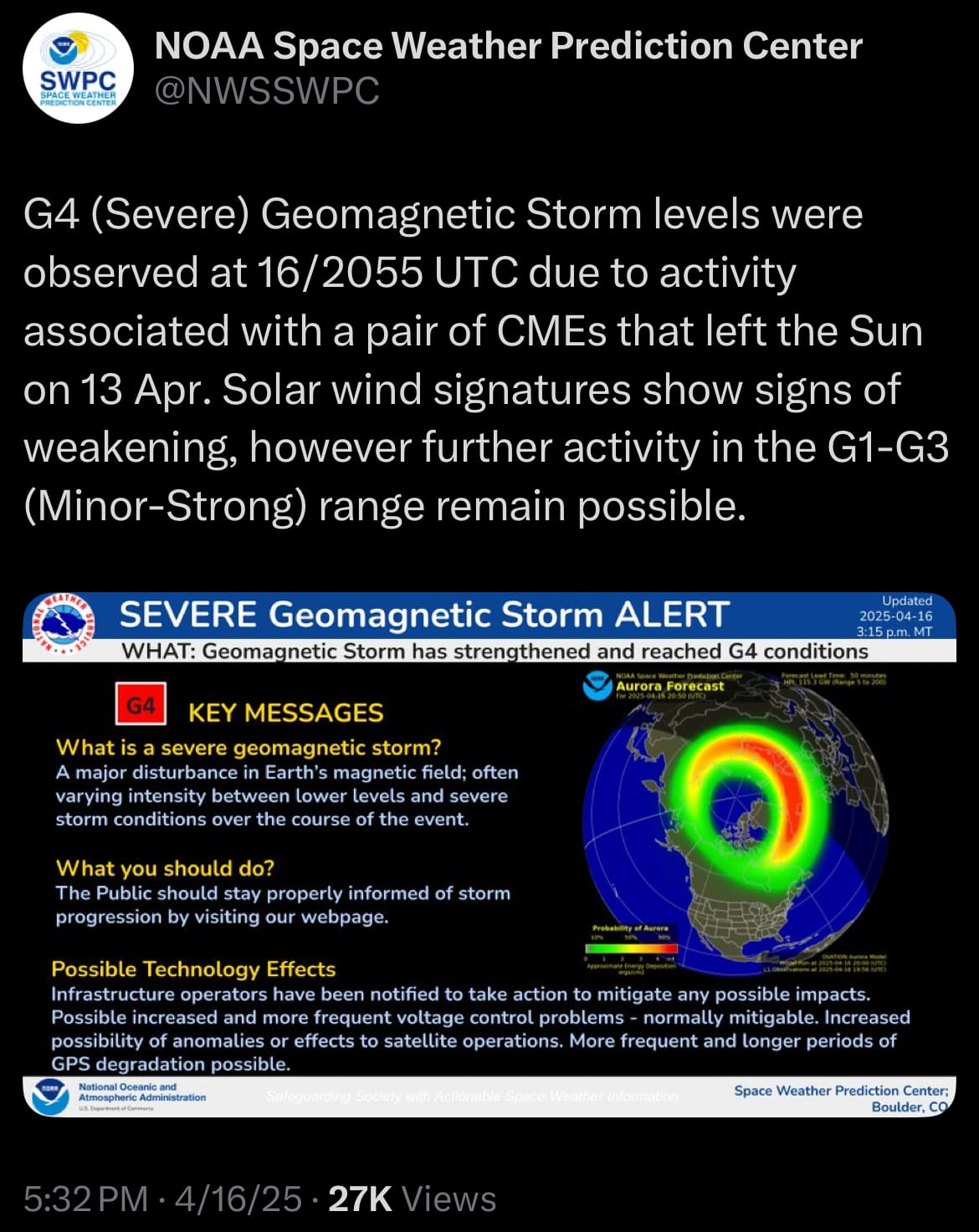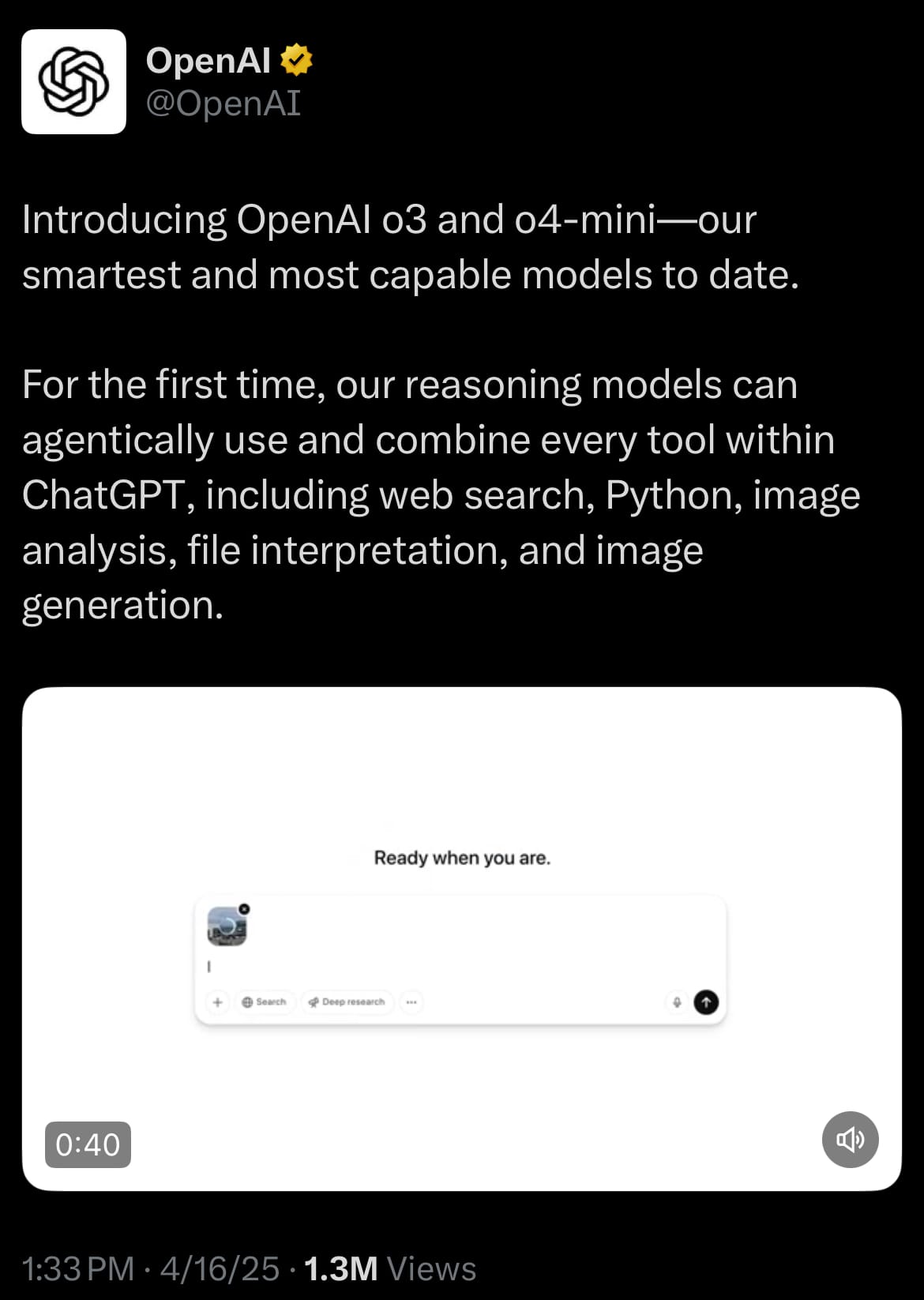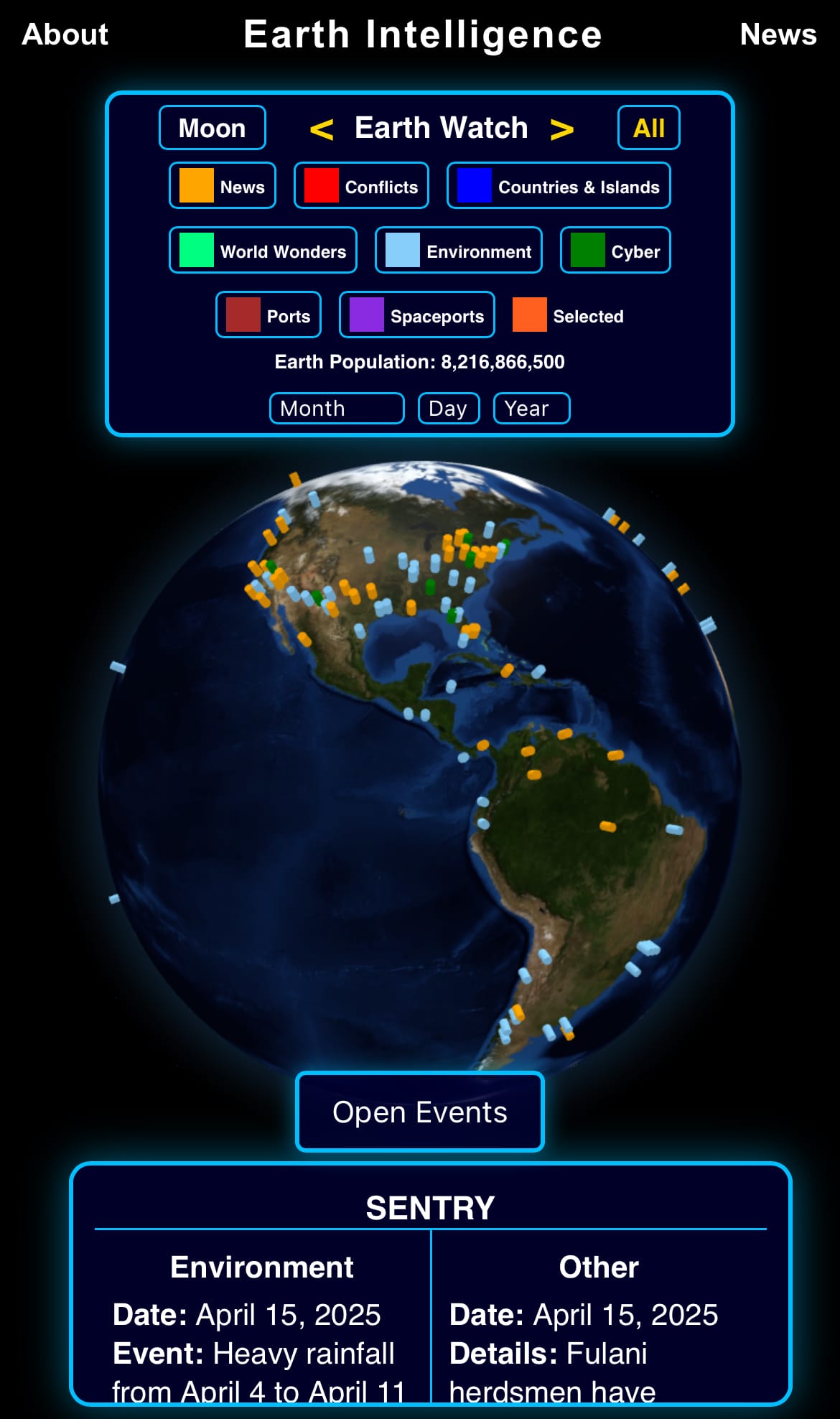Thursday☕️

Trending:
- Yesterday, April 16, 2025, a power outage struck Puerto Rico, affecting electricity customers starting around 12:40 p.m. The blackout was caused by a failure in a transmission line connecting the EcoEléctrica and Costa Sur power plants, leading to the shutdown of all Genera Puerto Rico’s generating units, as reported by Josué Colón, the island’s energy director.

- This also caused a drop in internet connectivity, according to Netblocks. The outage stopped public transit, closed businesses, and left about 78,000 people without water.
Economics & Markets:
- Yesterday’s U.S. stock market:

- Today’s commodity market:

- Today‘s crypto market:

Environment & Weather:
- Yesterday, April 16, 2025, a G4 geomagnetic storm impacted Earth, triggered by solar eruptions from April 13, according to the National Weather Service’s Space Weather Prediction Center. Classified as severe with a K-index of 8, the storm peaked in the afternoon and had the potential to affect power grids, satellites, GPS, and radio communications. It was among the stronger geomagnetic events in the current solar cycle, though it weakened later in the day, with minor to moderate activity forecast for April 17. Relevant authorities were informed to monitor and manage any disruptions to critical infrastructure.

- The storm generated auroras visible in parts of the northern United States, including states like Illinois and Oregon, as well as regions in the UK and New Zealand’s South Island. These displays, caused by solar particles interacting with Earth’s magnetic field, were observable in areas with clear skies and low light pollution, resembling auroras from a G4 event in October 2024. While the auroras attracted attention, the storm’s potential technological impacts prompted ongoing monitoring, with conditions expected to return to normal by April 18-19.

Space:
- Yesterday, April 16, 2025, a Northrop Grumman Minotaur IV rocket launched from Vandenberg Space Force Base in California at 12:33 p.m. PDT, marking the first use of this rocket at the site in 14 years. The mission, designated NROL-174, was conducted from Space Launch Complex-8 and carried classified payloads into low-Earth orbit for the National Reconnaissance Office (NRO) and the U.S. Space Force Space Systems Command. The Minotaur IV, built with solid rocket motors from decommissioned Peacekeeper missiles, is part of the NRO’s effort to deploy a constellation of satellites for intelligence, surveillance, and reconnaissance purposes. Specific details about the payloads remain undisclosed due to their classified nature.
- The launch is one of several recent activities at Vandenberg, following a SpaceX Falcon 9 mission on April 12 from Space Launch Complex-4E. The Minotaur IV’s return to Vandenberg reflects ongoing efforts to utilize existing missile technology for space missions. The NRO has additional Minotaur launches planned, including STP-29A and USSF-261S-A, indicating sustained activity at the base. Vandenberg continues to serve as a key facility for U.S. space operations, supporting a range of government and commercial launches.
Science & Technology:
- Yesterday, April 16, 2025, OpenAI announced two new AI models, o3 and o4-mini, aimed at enhancing reasoning and multimodal capabilities. The o3 model is designed for complex tasks such as coding, mathematics, and scientific analysis, achieving an 87.7% score on the GPQA Diamond benchmark. The o4-mini, a smaller model, focuses on cost-efficiency and speed, scoring 99.5% on the AIME 2025 math competition when paired with a Python interpreter. Both models can process images, browse the web, execute code, and use tools autonomously. They are currently available to ChatGPT Plus, Pro, and Team subscribers, with API access expected soon.

- OpenAI also introduced Codex CLI, an open-source tool for developers to write and edit code via natural language in a terminal. Compatible with o3 and o4-mini, it supports a 200,000-token context window and can interpret screenshots or sketches. Additionally, OpenAI launched a $1 million API grants program, providing $25,000 in credits to support projects using Codex CLI and other tools. The announcements align with OpenAI’s efforts to advance AI tools in a competitive landscape.
Statistic:
- Largest public automakers by market capitalization:
- 🇺🇸 Tesla: $776.95B
- 🇯🇵 Toyota: $228.48B
- 🇨🇳 BYD: $145.48B
- 🇨🇳 Xiaomi: $137.80B
- 🇮🇹 Ferrari: $77.83B
- 🇩🇪 Mercedes-Benz: $55.17B
- 🇩🇪 Volkswagen: $51.69B
- 🇩🇪 BMW: $49.63B
- 🇩🇪 Porsche: $45.48B
- 🇺🇸 General Motors: $43.99B
- 🇮🇳 Maruti Suzuki India: $42.55B
- 🇯🇵 Honda: $41.23B
- 🇺🇸 Ford: $37.37B
- 🇮🇳 Mahindra & Mahindra: $37.22B
- 🇰🇷 Hyundai: $31.34B
- 🇨🇳 Seres Group: $29.31B
- 🇳🇱 Stellantis: $27.17B
- 🇮🇳 Tata Motors: $26.76B
- 🇨🇳 SAIC Motor: $24.65B
- 🇰🇷 Kia: $23.73B
- 🇨🇳 Great Wall Motors: $23.32B
- 🇨🇳 Li Auto: $22.67B
- 🇯🇵 Suzuki Motor: $22.61B
- 🇨🇳 Geely: $20.22B
- 🇨🇳 XPeng: $17.97B
History:
- The history of advanced medical technology reflects a progression from basic instruments to complex systems that have reshaped healthcare. In the 19th century, the stethoscope (1816), developed by René Laennec, improved diagnostic capabilities by allowing doctors to hear internal sounds. The discovery of X-rays in 1895 by Wilhelm Röntgen introduced non-invasive imaging of bones and tissues. The 20th century brought electrocardiography (ECG) for heart monitoring, dialysis machines, and insulin pumps. The 1970s saw the advent of computed tomography (CT) scans, followed by magnetic resonance imaging (MRI) in the 1980s, enhancing diagnostic precision. These developments, resulting from collaboration across scientific fields, established the foundation for modern medical practice, enabling earlier detection and more effective treatments.
- Since the late 20th century, medical technology has advanced rapidly with digital and biological innovations. The Human Genome Project (1990–2003) enabled genetic research, contributing to targeted therapies like CRISPR gene editing in the 2010s. Robotic surgery systems, approved in the early 2000s, improved precision in operations. Wearable health monitors and telemedicine expanded access to care, while artificial intelligence (AI) began supporting diagnostics and drug development. Technologies like 3D-printed prosthetics and tissue engineering also emerged. These advancements have enhanced healthcare delivery and patient outcomes, though issues such as high costs, access disparities, and ethical questions continue to prompt discussion about their implementation and impact.
Image of the day:

Thanks for reading!
Earth is complicated, we make it simple.
Click image to view the Earth Intelligence System:



Support/Suggestions Email:
earthintelligence@earthintel.news




